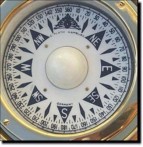

Ship's Equipment in the 1950 - 60's |

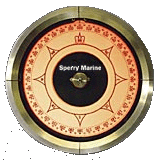

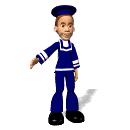
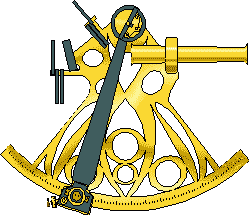


Polished weekly by apprentices ... never used ! |

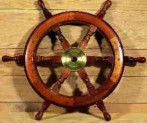

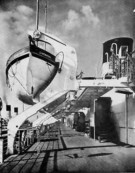
....uniforms were worn at all times ? ? |
The Gyro |


Tools and equipment As apprentices (the lowest form of marine life) we were kept busy maintaining deck equipment and fittings, this meant that we were frequently employed for long periods chipping and scraping the steel decks, bulwarks, rails, bulkheads, deckheads. We did not appreciate it at the time but our having done this work meant that by the time of our exams we had no problems with doing our ship constructions drawings. The bulkheads and bulwarks when they had been cleaned of all previous paint and rust they were wire brushed, pumiced down, dusted off then given a coat of boiled linseed oil then when that had dried the steel was coated with paint. One coat red lead then one coat of red lead with a touch of white flat, then one white red lead mix half and half, then one flat white paint, finished with two coats of gloss white. Steel rails were stripped of their outer coats of paint and rust by the means of galvanised (spark proof) chain being drawn around the rails backwards and forwards manually. The tools used were hand held chipping hammers, or for large areas we did get to use pneumatic driven chipping hammers. Straight handled chisel, gooseneck, fish tail were different types of scrappers. Red lead paint was made on board by ourselves in the early years with the raw products being linseed oil and bags of red lead powder which we had to mix to the right consistency by swirling a broom handle through the neck of a five gallon drum, over a period of time the broom handle became a paddle with all the accumulated coats of paint therefore a better paddle. The wooden decks were holystoned, that is wetted then sand put on it and this was ground into the wooden decks by the use of sandstone blocks which were rubbed backwards and forwards (with the grain) on the deck that had been wetted with salt water, this holystoning was done by kneeling on the deck, or there were long handled holystone holders available on rare occasions. The wooden decks were caulked between the timbers with oakum (coir fibre) that was twisted into a rope and driven into the seam between the timbers by means of caulking tools (various chisel head types) and a special hammer, then sealed by application of hot pitch, making sure that as little as possible pitch got on to the timber, as your next task was to removed the excess dried pitch by scraper and holystone, the excess would leave a stain on the deck, so you took pride in neat black straight lined seams of pitch on the gleaming white timber decks. It took time to become adept at using caulking tools and hammer as the caulking hammer had a big cross head and this when learning caused you to hit your own hand and cause large swellings between thumb and forefinger of your left hand, but in time you learn. Heating of the pitch was a problem on a tanker, if working aft on the boatdeck you could get the use of the galley as long as it was not in use (but not popular with the cook because of the smell of hot pitch) but when working amidships it was a long way to carry the special bucket and the pitch would cool and be that much ticker when poured via the long fine spout into the seams. In the tropics, as we had no air conditioning we used to deploy canvas awnings to shade the wooden deck, and early in the morning we would wet the wooden decks with seawater from hoses and as the timber dried there was a cooling effect of the evaporation. We had to varnish some woodwork, doors, ladders rails and before the days of bought varnish we made our own from crushing half pound rosin to four pounds boiled linseed oil, stir until dissolved then add half a gallon of turpentine to make a spar varnish but other mixtures required for other types. Steel wire stays on davits et, suffered at the hands of sea spray and they would rust and have to be replaced, to delay this we used to wire brush all standing wires then give them a thick coating of white lead and tallow. Running wire gear on the derricks were treated to a wire brushing and a thick coat of fish oil (very smelly). Lifeboat wires had to be turned end to end to prolong their life. It was a fiddly job and with the anchor point being three inward turns of the wire in an enclosed space you lost quite a bit of skin in the process. But the job had to be right your life would depend on everything working correctly when you needed it, this work required hammer, chisel, vice seizing and wire grease, paraffin and cotton waste to clean the working surfaces clear of oil especially on the break surfaces. The list of work was endless. But rather than write the whole list it would be easier to say that we knew and became practiced in the contents of the Boatswain's Manual 1944 edition and has now be revision by Captain AGW Miller for the fifth edition dated 1997 and is printed by Brown Son & Ferguson Ltd, 4-10 Darnley Street, Glasgow. |

Apprentice Jobs |
The Navigation Bridge Whilst looking sparse by present day standards it was equipped with all that was required for us to be able to navigate safely between A and B.The deck was a wooden caulked deck with runners of coir mats between the doors. There was a wooden grating on which the helmsman (secunny) stood at the steering position. Captains high (wooden) chair. Which was only used by the Captain and then only when he had been on the bridge for many hours, as when we had been navigating in fog. Voice pipe consisting of a brass whistle that was positioned in a brass funnel which was part of a cloth covered rubber pipe that was let into a metal pipe that went down to beside the Captains bunk, also by his desk in his day room, and at his end there was a similar brass whistle arrangement. To use the whistle take the whistle out of the brass holder, and blow hard into the funnel, this would cause the whistle in the Captains room to blow, he would then take his whistle out and speak into the pipe, and you would hear what he said by putting the funnel at your end to your ear, simple system which worked without the need for electricity. Telescope large either leather or if old, duck canvas covered and decorated with Turks head ropework. Telescope kept hung on wall brackets. Binoculars 7 x 50 ships property kept in a box on the bridge front but most navigation officers carried their own as well. Square windows. These bridge front windows were large and you could if in an emergency have climbed through them. The glass was heavy armour plated glass which was intended to be able to resist the weight of heavy seas, the windows had heavy brass handles on the top and the glass was supported by a hydraulic metal scissors systems hidden behind the timber lining of the bridge front. Clear view screens. Motorised circular windows which revolved and threw the moisture off the glass making much better forward vision possible. Flag locker. Containing a full suite of alphabetical, substitute, numerical as well as a good range of national courtesy flags which it was essential to fly to reduce the possibility of offending some of the poorer, new and very proud nations that we visited. Aldis lamp. Hand held with a wandering lead that allowed for ease of use which was extensive on long sea passages, as we used to enquired on passing vessels name destination etc. But if going in the same direction we might be in company for several days and chat on all sorts of matters, and in this way we became adept in the use of the Aldis. Ships whistle. A large brass button located on either side of the bridge this could be manual for use in port to instruct tugs, or could be set to automatic, then it would sound one long blast at intervals of not more than two minutes when the vessel was in fog. Norwegian fog horn. A suitcase sized wooded box that had a handle which had to be cranked by hand to produce a Fog Sound Signal nowhere as loud as the ships steam powered fog signal audible at two miles but the Norwegian system would work even when in a Dead Ship condition. Clinometer or Inclometer. This was a weighted pointer, hinged at the top with the pointer free running against a graduated scale which indicated the extent of degrees of the list/roll. Again being able to work when in a Dead Ship condition. Doors. All doors could be hooked open and had "kick in panels" Emergency Navigation Lights. Run on Colza (rape seed) oil. Telephone. Single number of destinations, focsle head, poop, ER, Captains day room/bedroom etc. Echo Sounder. Moist paper type, which could be set to any of three scales. There was a need to interpret what you saw, as you could get false echoes from cold water (thermoclines) or very poor echo from soft mud bottoms. Also there was a clutter directly close under the hull. Degausing gauge. A box in the early days when we were still fitted with Degausing wires about the hull at deck level to counteract the possibility of setting of magnetic mines. Radar. Cossor Mk 2 "Lease Lend" type that frequently required shipboard repair or repaired when the right spares available when we got into port. Clock. Brass ships clock, this was checked against the chronometer in the chartroom, and all the other clocks in the ship (except the ER who did their own at an agreed time with the bridge) had to be changed manually by the second officer whenever the clocks were changed eg thirty minutes per night. Steering wheel. Central position at the back of the bridge space allowing uninterrupted path from one wing to the other by the duty officer. The wheel had either a brass cup or a Turks head ropework on the spoke that was at top dead centre when the wheel was amidships and the rudder also amidships. This was so the helmsman could know the wheel position even in the dark. Gyro compass. Midships in front of the steering position, and in later years the Gyro was also equipped with automatic steering which could be used on sea passages. The make was usually Sperry but on or two of the ships had Brown. In both cases the actual Gyro was located in a steel room under the midships accommodations (as the rotor was said from memory to revolve at 6,000 rpm no one wanted it get out of it's casing!!) Magnetic compass. Mounted on the monkey island there was a periscope set down through the deckhead, and the mirror allowed the helmsman to steer the ship by magnetic compass if required. Voice pipe. From the helmsman position also in the deckhead was a copper voice pipe to the monkey island and this would be used by the watch keeper when taking bearings on the monkey island and needing to speak to the helmsman. Engine Revolution Counter. Showed how many propeller revolutions were being made ahead or astern per minute, helpful when manoeuvring in port, to see how quickly the engineers were able to respond to the telegraph. You could fee the response as quickly through your feet or see the puff of smoke from the funnel, and the change in the wash at the stern. Radio Auto Alarm. This was a system of alarm bells that was set off if a ship was to transmit on the distress frequency, and the Radio Officer was to be called immediately He had an alarm in his cabin and would respond immediately but he would need a call say if he was in the saloon or smoke room. The vast majority of these alarms were false, having been triggered by distant thunder storms, but most alarms were heard if we were near northern European waters and then they had to all be treated as real until proven to be false. Small hatch to radio room. Allowed direct contact with the Radio Officer. Large window to chart room. Allowed forward vision from the chart table . Bank of light switches. These controlled the Navigation lights on one box which had a plan of the ship, the other bank were to control the floodlights on deck all over the ship. Ash trays. Ronson approved type as we were on tankers (stub butts into air tight vertical squares). Or we had sand filled tins for ashtrays. Telegraphs. Two positions from which engine instructions could be relayed to the engine room by the position of the handle. |
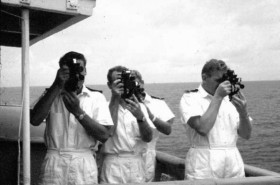
Midday Sights... before GPS |
Uniforms were worn at all times on board if "on watch" or public places, but caps
were only worn when pilots/shore people were on board, and of course during any
formal event such as "Board of Trade sports" (fire and boat drills at 16.30 Saturdays
at sea), Sunday inspections and funerals at sea. Whites with epaulettes, short trousers, long socks and white shoes were worn if the temperatures was + 70°F. Blues were worn if the temperature was under 70°F (but on ship we went into blues when in the Red Sea and the temperature was 75°F because we were "feeling the cold" after six months when we had no recorded level of under 83°F day or night. If working cargo, or tank cleaning "white overalls" were worn, but at that time I never remember any of us wearing safety helmets such as those worn by refinery personnel. |
All navigating officers carried their own sextants, as it was very rare for the shipping
lines at that time to supply a sextant for the ship other than on some
large cadet training vessels run by the older companies. |